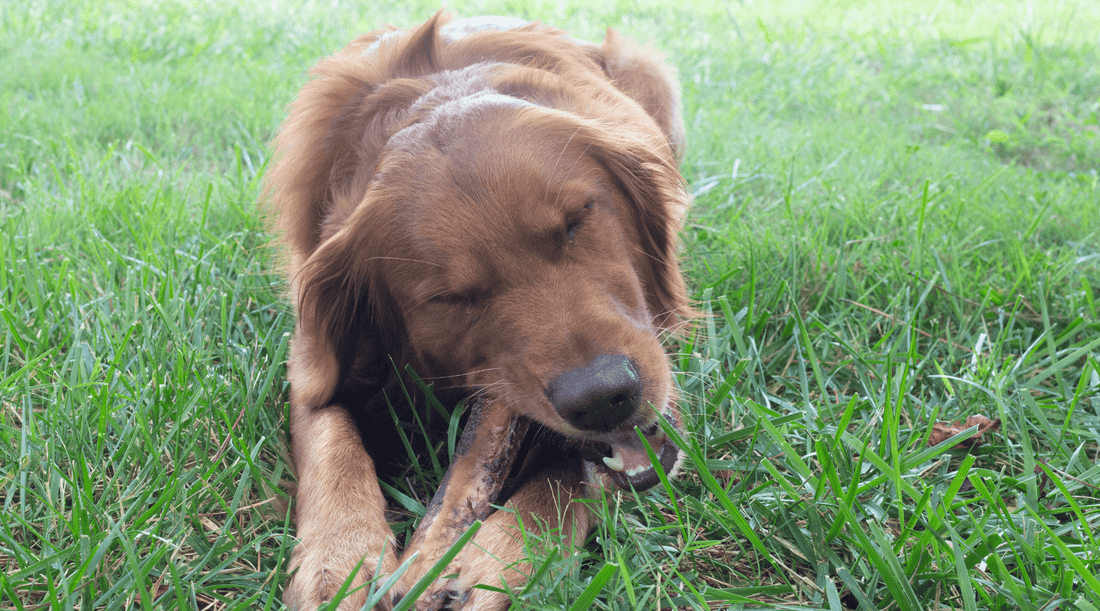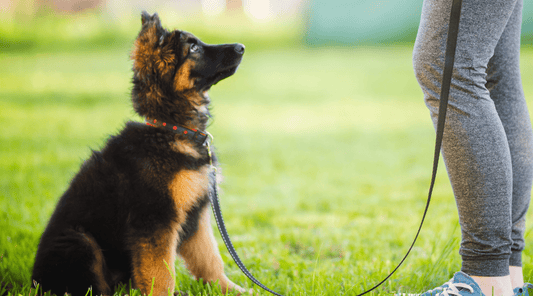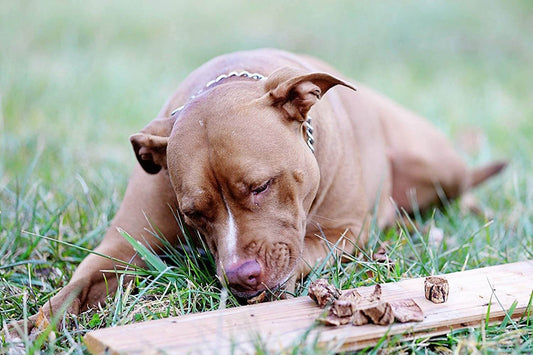
Strategies for Managing Destructive Dog Chewing
Dawn Miller Oct 22, 20244 Minute ReadIt was a disaster zone. And at the heart of it all? Bruno, our mischievous lab mix, proudly wagging his tail amidst the shredded remains of what used to be the beautifully carved walnut leg of our new dining table.
He hadn't even bothered to flee the scene of the crime. He was just happy to see us. I can't really say I felt the same.
Why? What led my sweet Bruno into this life of crime? A mix of boredom, anxiety, and the absence of any real chewing outlet. In this guide, we'll peel back the layers of this mystery and discuss how the best bones for dogs can help.
Why Dogs Chew on Things They Shouldn't
Dogs have a lot of reasons for chewing on things, from teething to canine anxiety. Dogs chew on dog bones (or table legs) for entertainment, to alleviate boredom, and because it feels good. If that dog bone is filled with something tasty like bone marrow, they get a little dopamine hit every time they release a little filling. Yum!
Every dog parent needs to know why dogs chew to stop destructive chewing.
In Bruno's case, it was clear—he had a lot of pent-up energy and no proper outlet. We had gone for our usual walk right before we left for the show. But one walk wasn't going to make a difference. There was some bigger reason Bruno was gnawing.
Chewing on dog bones is instinct for a dog. They feel the drive to do it. It dates back to their ancestral wolves cleaning a deer and ensuring they ate all of it because they didn't know where their next meal would come from. But also because different parts of the animal have different nutrients.
Okay, the dogs don't know about the nutrients or the fact that dogs that chew on bones have 60-80% less harmful bacteria in their mouths, helping them keep their teeth.
But dogs that chewed bones were probably healthier and survived to pass this instinct on to their offspring and then to domesticated dogs. Bone marrow is rich in some key components that aren't as prevalent in other parts of the body, namely collagen, glucosamine, chondroitin, and vitamin C.
What does all this have to do with my shredded sofa pillows, mangled running shoes, or re-imagined dining table? If dogs don't have a big juicy dog bone that satisfies that need, they will act out. They find things to chew, shake, and obliterate to feed that need.
And the best chew bones for dogs can make a big difference.
Can Dogs Have Bones?
Yes. When properly prepared, real dog bones can be an important part of your dog's diet and lifestyle routine. These dog bones must be the right size (bigger than your dog's head in one direction) and cooked correctly to achieve the right density.
While dogs can chew on dog bones, some have more health benefits than others. Some even expose dogs to additives and potentially harmful chemicals.
The Dog Bones I Won't Buy
- Rawhide. It's made from the dried skin of an animal shaped into a bone. Drying skin requires potentially harmful chemicals, some of which remain on the bone. That's not the only reason. I discuss this further in my article: No Raw Bone: A Tasting Party for My Pups.
- Dog Bone Shaped Treats. Some treats claim to clean teeth, but they don't provide that full dog bone chewing experience. Often, these have lots of ingredients you can't pronounce and added sugar because they don't taste good without it.
- Cooked Dinner Bones & Bone Broth Bones. If you've already cooked the bone, then it becomes too soft. It can splinter and cause a choking hazard.
- Raw bones. Now, these are better than the others because they're generally safe. But I'm not a big fan of having my dogs dragging raw meat around my home and licking my face after. The American Veterinary Medical Association recommends against raw pet food.
Managing Destructive Chewing with a Chewing Routine
Setting up a routine is critical. It sets a rhythm to dog bone chew time so dogs can look forward to it. My lab mix, Bruno, no longer feels the need to act out. He knows that when we go out for several hours, he'll have a chew session when we return.
Your own personal chew routine will work best if it matches the lifestyle you've created and built with your dogs. So, here are some things to consider
How Often to Give Dog Bones
The American Kennel Club recommends that treats be no more than 10% of a dog's diet. So, we try to stick with this. I've done the math, and this comes out to around 15-20 minutes 3 times a week. Now, one of my friends likes to give her dog a bone every day when she gets home from work, kind of like a reward for being good all day. So, her chew sessions are shorter to compensate—around 10 minutes.
Timing Your Chew Routine Around Events
Do what works for you. If you're going to be gone all day at work, you might like to time chew sessions in the morning as part of your get-ready routine. Just don't forget to retrieve the bone before you head out for the commute. But I've heard a lot of you say this would never work for you. You're too rushed—especially those of you with small kids.
So, here are some other options.
It's best to start a new habit by associating it with something you already do, like:
- Brewing coffee
- Lunchtime
- Getting home from work
- Making dinner
- Before your evening walk
- Winding down for a little TV before bed
Making Bones Last Longer
Real dog bones aren't the one-and-done that most other bones are. They can stand up, even to aggressive chewing. When it's time to take the bone away, I play a trade game with my dogs. "Hey. Pixie. (that's my terrier). Here's a tasty collagen-rich beef lung bite." She drops the dog bone immediately. I freeze it for later. We can get many weeks out of one bone this way.
And when the marrow is gone, I can stretch one bone out further by refilling it with tasty treats from my dog bone refill guide. You can download it for free.
Choosing The Best Bones for Dogs Chew Routine
Beef marrow bones are sturdy bones with the right density and a variety of sizes, so no dog is too big or too small to enjoy a beef marrow dog bone treat. I also look for single-ingredient dog chew bones, so there's nothing weird in them.
Since I care a lot about nutrition and my dogs deserve the best, I choose bones from grass-fed beef cattle. They're more nutritious!
You can see the bones Bruno loves here.Available On:





